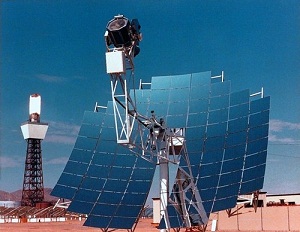US power needs met by existing solar
 During the 2010 IEEE (Institute of Electrical and Electronics Engineers) Innovative Technologies for an Efficient and Reliable Electricity Supply Conference, at least one physicist will present a plan to make the United States energy independent by using existing solar technology to supplant fossil fuel and nuclear power plants as they become inoperable. A. Sidney Johnston, a physicist and patent attorney with Cesari & McKenna law firm in Boston, will present his research at the Boston conference being held between Sept. 27 and 29.
During the 2010 IEEE (Institute of Electrical and Electronics Engineers) Innovative Technologies for an Efficient and Reliable Electricity Supply Conference, at least one physicist will present a plan to make the United States energy independent by using existing solar technology to supplant fossil fuel and nuclear power plants as they become inoperable. A. Sidney Johnston, a physicist and patent attorney with Cesari & McKenna law firm in Boston, will present his research at the Boston conference being held between Sept. 27 and 29.
Johnston told Clean Energy Authority that an area roughly 100 square miles in the United States could provide all the country’s electrical needs. He proposed using solar reflectors coupled with stirling engines to produce electricity.
“Reflectors are advertised at 30 percent efficiency,” he said, which is higher than most photovoltaics. He modeled a system based on 10 kW units. According to his research, the use of 160 million 10 kW reflectors should meet all the United States’ electricity needs.
The systems, designed modularly, would be backed up with a system that electrolyzes purified water into its constituent elements, hydrogen and oxygen. The highly combustible gasses would be used to fire a non-polluting gas-turbine, producing electricity for use at night and when it’s too cloudy for the solar systems to work at efficient levels. The backup generation would be about 50 percent efficient, considering the losses from electrolysis, Johnston said.
Overall, these units would need roughly 100 square miles of land, which he called a “postage stamp” compared to available land. However, getting a 100-square mile area to produce all the United States’ electricity needs would be—at the very least—a permitting nightmare. To help get around this, he said the systems could be made as modular 1,000 megawatt units of 10 square miles, or smaller.
Of course, transporting all that electricity across the continent presents an issue.
“The transmission lines are a problem, but I understand that a superconducting conducting company claims they can do lines,” he said, with little or no efficiency loss.
While he said liquid-nitrogen-cooled, superconducting power lines haven’t been tested, “the folks at American Superconductors say it should work just fine…otherwise you get the usual loss in power lines.”
The cost analysis for such a plan has yet to be completed.



